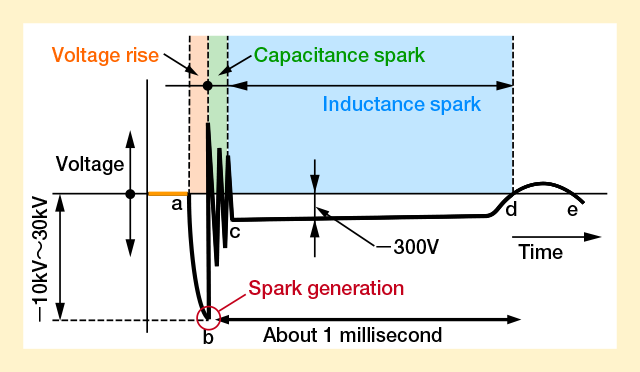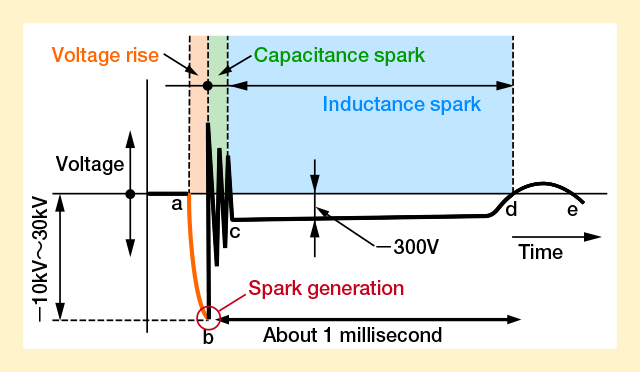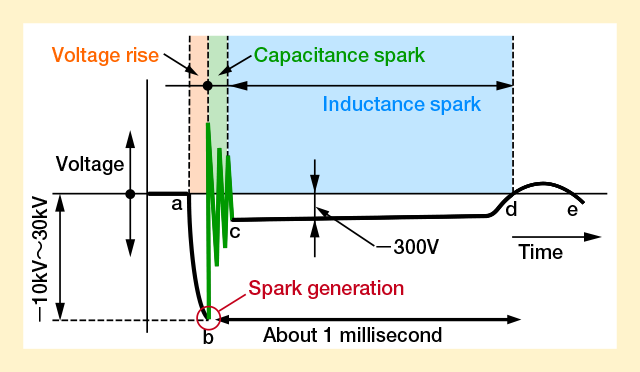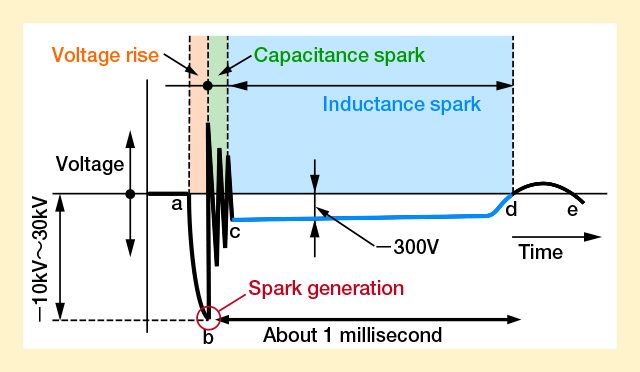Spark and Ignition
Spark
When the high voltage produced by the ignition system is applied between the center electrode and ground electrode of the spark plug, the insulation between the electrodes breaks down, current flows in the discharge phenomenon, and an electrical spark is generated.
This spark energy trigger ignition and combustion in the compressed air-fuel mixture.
This discharge is of extremely brief duration (about 1/1000 of a second) and is extraordinarily complex.
The role of the spark plug is to reliably generate a strong spark between the electrodes accurately at the specified time to create the trigger for combustion of the gas mixture.
When the high voltage produced by the ignition system is applied between the center electrode and ground electrode of the spark plug, the insulation between the electrodes breaks down, current flows in the discharge phenomenon, and an electrical spark is generated.
This spark energy trigger ignition and combustion in the compressed air-fuel mixture.
This discharge is of extremely brief duration (about 1/1000 of a second) and is extraordinarily complex.
The role of the spark plug is to reliably generate a strong spark between the electrodes accurately at the specified time to create the trigger for combustion of the gas mixture.
Ignition
Ignition by electrical spark occurs because the fuel particles between the electrodes are activated by the spark to discharge, a chemical reaction (oxidation) is triggered, the heat of reaction is generated, and the flame core is formed. This heat activates the surrounding air-fuel mixture, eventually a flame core is formed that spreads the combustion to the surroundings itself.
However, if the quenching effect between the electrodes (the work of the electrodes absorbing the heat and extinguishing the flame) is greater than the flame core heat generation action, the flame core is extinguished and the combustion stops.
If the plug gap is wide, the flame core is larger and the quenching effect is smaller, so reliable ignition can be expected, but if the gap is too wide, a large discharge voltage becomes necessary, the limits of the coil performance are exceeded, and discharge becomes impossible.

Change in the discharge voltage
The ignition system normally generates 10-30 kV secondary voltage.





- Voltage rise
- Spark generation
- Capacitance spark
- Inductance spark
Click the number of the text.
- When the primary current is cut off at the ‘a’ point, the secondary voltage rises.
- At the ‘b’ point, partway through the rise in voltage, the spark plug reaches the discharge voltage and a spark is generated between the electrodes.
- Between ‘b’ and ‘c’ is called the capacitance spark. At the start of the discharge, the spark is generated by the electrical energy stored in the secondary circuit. The current is large but the duration is short.
- Between ‘c’ and ‘d’ is called the inductance spark. The spark is generated by the electromagnetic energy of the coil. The current is small but the duration is long. From the ‘c’ point, the discharge is continued for about 1 millisecond and at the ‘d’ point, the discharge ends.
More Information
You can read more detailed explanations about sparking and ignition.
